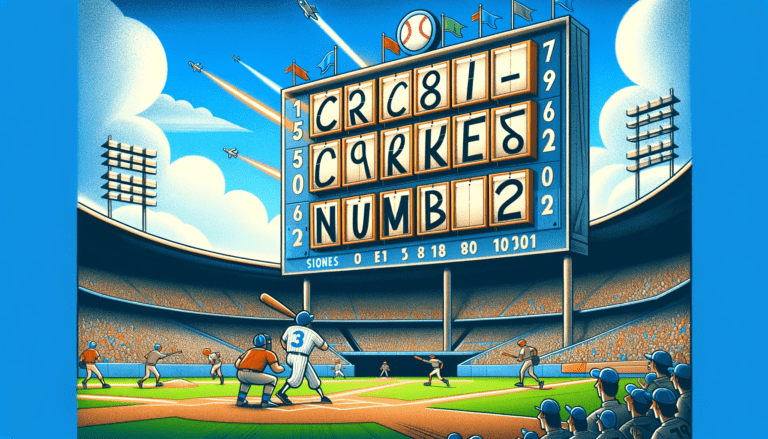What Does K Mean in Baseball?
When you’re watching a baseball game, you might see the letter “K” frequently appearing on the scoreboard or in the box score. But what does it mean?
Simply put, a “K” in baseball refers to a strikeout. Every time a batter strikes out, it is recorded as a “K” on the scorecard. Strikeouts are crucial in baseball because they are one of the primary ways for a pitcher to get an out. A high strikeout rate is often seen as a sign of a dominant pitcher.
Understanding baseball’s scoring symbols like “K” can help you better follow the game’s action and appreciate the strategies employed by teams and players.
Key Takeaways
- The ‘K’ symbol on a baseball scoreboard represents a strikeout, marking a pitcher’s success in retiring a batter without the ball being put into play.
- Henry Chadwick, a sportswriter and baseball statistician, is credited with introducing the ‘K’ as a scoring abbreviation due to the prominent ‘k’ sound in ‘strike’.
- Strikeouts are significant for both pitchers and batters, affecting their statistics and how they are perceived in terms of skill and performance.
- MLB history is rich with standout strikeout performances, with pitchers like Nolan Ryan and Randy Johnson setting remarkable career records.
- Pitching techniques, mental strategies, and rigorous training are all crucial for a pitcher to earn a ‘K’ and excel in the art of striking out batters.
The Origin and Significance of ‘K’ in Baseball Scoring

Historical Roots of the ‘K’
The letter ‘K’ has been a part of baseball’s unique lexicon for well over a century. Its adoption as baseball term is credited to Henry Chadwick, a sportswriter and baseball statistician, who is often referred to as the ‘father of baseball scoring’.
Chadwick chose the letter ‘K’ to represent foul ball and a strikeout in his scoring system because ‘K’ is the prominent letter in the word ‘strike’, which was already in use to describe the act of missing a pitch.
The simplicity of the ‘K’ symbol made it easy for scorekeepers to quickly note a strikeout on their scorecards. This efficiency was crucial in an era before electronic scoreboards and instant replays.
Over time, the ‘K’ became universally recognized in the game of baseball, transcending language barriers and becoming an integral part of the sport’s culture.
- Henry Chadwick’s influence on baseball scoring
- The practicality of using ‘K’ for scorekeeping
- ‘K’ as a universal symbol in baseball
Why ‘K’ Represents a Strikeout
The letter ‘K’ has been synonymous with a strikeout in baseball since the 19th century. Its use is attributed to Henry Chadwick, a sportswriter and baseball statistician, who chose the letter ‘K’ because it was the last letter in ‘struck,’ which was the common term for a strikeout at the time.
Chadwick preferred ‘K’ over ‘S’ to avoid confusion with ‘sacrifice’ and ‘stolen base,’ which were already denoted by ‘S’ in the scoring system.
The ‘K’ has since become an integral part of baseball’s unique language, serving as a quick and clear way to communicate one of the game’s most critical outcomes.
Here’s how ‘K’ is used in various contexts:
- A forward ‘K’ indicates a strikeout swinging.
- A backward ‘K’ signifies a strikeout looking, where the batter does not swing at the final strike.
- In a pitcher’s stats, ‘K’ represents the total number of strikeouts they have achieved.
- For batters, a high number of ‘K’s can be seen as a negative, reflecting a susceptibility to strikeouts.
The Impact of ‘K’ on Baseball Culture
The letter ‘K’ has transcended its initial role as a simple scoring notation to become an iconic symbol in baseball culture.
Fans and players alike recognize the ‘K’ as a testament to a pitcher’s skill and a moment of high drama in the game.
- The proliferation of ‘K’ signs in the stands during games, especially when a star pitcher is on the mound, highlights its significance among the audience.
- Strikeout milestones are celebrated extensively, with pitchers who accumulate high ‘K’ counts revered in the annals of baseball history.
- The ‘K’ has also influenced baseball language, with terms like ‘strikeout artist’ or ‘king of the K’ becoming part of the sport’s lexicon.
Ultimately, the ‘K’ is more than just a scorecard entry; it’s a symbol of prowess and an integral part of the narrative that unfolds on the diamond.
Read Also: What Does ERA Mean in Baseball
Understanding the Scoreboard: Reading the ‘K’

Deciphering the Scoreboard Symbols
To the uninitiated, a baseball scoreboard can seem like a cryptic array of numbers and letters. Among these symbols, the ‘K’ holds a special place as it denotes a strikeout. When a pitcher successfully strikes out a batter, a ‘K’ is recorded on the scoreboard.
This can be seen in various forms:
- A forward ‘K’ indicates a swinging strikeout.
- A backward ‘K’ signifies a strikeout looking, where the batter did not swing at the third strike.
Understanding these symbols is crucial for fans. They help follow the game more easily. The symbols provide quick insights into the performance. They cover both pitchers and batters throughout the contest. You may read the guide on What Does GIDP Mean in Baseball
The Role of ‘K’ in a Pitcher’s Stats
In baseball statistics, the ‘K’ is a critical marker for pitchers, signifying their ability to retire batters through strikeouts.
A high number of ‘K’s is often indicative of a pitcher’s dominance over opposing hitters, reflecting their skill in making pitches that are difficult to hit.
- The ‘K’ count contributes to a pitcher’s strikeout-to-walk ratio (K/BB), an important metric that evaluates control and efficiency.
- Seasonal and career strikeout totals are closely watched, as they can be a factor in awards and contract negotiations.
- A pitcher’s game-by-game ‘K’ tally is also a key component of their game log, providing insight into their performance in specific matchups.
How ‘K’ Affects a Batter’s Record
In the world of baseball, a batter’s record is a comprehensive reflection of their performance at the plate. The prevalence of ‘K’ on a player’s stat sheet can have significant implications.
A high number of strikeouts can be indicative of a batter’s struggle with pitch recognition or swing mechanics. Conversely, a low strikeout rate often suggests good plate discipline and contact skills.
- Strikeouts are a key metric in evaluating a batter’s vulnerability.
- They can influence a batter’s approach at the plate, potentially leading to more conservative swings.
- Over time, a pattern of frequent strikeouts may result in fewer opportunities to bat in crucial game situations.
Ultimately, while strikeouts are just one aspect of a batter’s record, they carry weight in the eyes of coaches, analysts, and fans.
A batter’s ability to minimize strikeouts can contribute to a more robust offensive profile and enhance their value to the home team’s pitcher again.
Read Also: What Does BB Mean in Baseball
Famous Strikeout Records in MLB History

Pitchers with the Most Career Strikeouts
The leaderboard for career strikeouts is a testament to the skill and longevity of the greatest pitchers in Major League Baseball (MLB) history.
Nolan Ryan sits atop this prestigious list, having set a seemingly insurmountable record with an astonishing 5,714 strikeouts.
Behind him are Randy Johnson, Roger Clemens, and Steve Carlton, each of whom has surpassed the 4,000-strikeout mark, showcasing their dominance on the mound over their illustrious careers.
These pitchers have not only racked up impressive numbers but have also left an indelible mark on the game.
Their ability to consistently retire batters via the strikeout has made them legends in the sport:
- Nolan Ryan: 5,714 strikeouts
- Randy Johnson: 4,875 strikeouts
- Roger Clemens: 4,672 strikeouts
- Steve Carlton: 4,136 strikeouts
Achieving a high number of strikeouts requires a combination of power, precision, and mental fortitude, qualities that these pitchers exemplified throughout their time in the league. You may read the ultimate guide on What Does 6 4 3 Mean in Baseball
Memorable Strikeout Performances in Key Games
Throughout the history of Major League Baseball, certain strikeout performances have left an indelible mark on the game.
The most strikeouts in a single game by a pitcher is 20, a feat that has been achieved by a select group of pitchers, including legends one game like Roger Clemens and Kerry Wood.
These outs’ performances not only showcase a pitcher’s dominance but also become a part of baseball lore.
Key games often turn on these moments of pitching prowess. For instance, during critical playoff matches or season-defining games, a pitcher’s ability to rack up strikeouts can be the difference between victory and defeat.
The tension in the stadium rises with each ‘K’ added to the scoreboard, as fans and players alike sense the growing momentum.
Some memorable strikeout performances include:
- Roger Clemens’ record-tying 20-strikeout game in 1986 and again in 1996.
- Kerry Wood’s 20-strikeout masterpiece in 1998, is often cited as one of the greatest pitching performances ever.
- Randy Johnson’s perfect game in 2004, featuring 13 strikeouts, etching his name in the history books.
The Evolution of Strikeout Rates Over Time
The landscape of Major League Baseball has witnessed a notable shift in the dynamics of scoring games between pitching and hitting, with strikeout rates climbing steadily over recent years.
This trend is highlighted by the significant increase in strikeouts, which has become a focal point for analysts and fans alike.
- In 2020, the league-wide strikeout rate reached a high of 23.4%, underscoring a shift in batting strategies and pitching prowess.
- The rise in strikeouts has sparked discussions about the balance between power hitting and contact batting, as teams and players adjust to the evolving nature of the game.
As the game continues to evolve, the increase in strikeouts presents both challenges and opportunities for players and teams to innovate and adapt their approach at the plate and on the mound.
See Also: What Does E Mean in Baseball
The Art of Pitching: How to Earn a ‘K’

Techniques and Pitches That Lead to Strikeouts
Mastering the art of the strikeout is a blend of skill, strategy, and execution. Pitchers utilize a variety of pitches, each with its own movement and speed, to outwit batters.
Fastballs, curveballs, sliders, and changeups are staples in a pitcher’s arsenal. They’re designed to disrupt a batter’s timing. Their goal is to induce swings and misses.
Effective pitchers also focus on pitch location and control. Throwing strikes consistently and painting the corners of the strike zone can significantly increase the likelihood of strikeouts.
Moreover, understanding a batter’s weaknesses allows a pitcher to exploit them, often leading to a decisive ‘K’.
To enhance their strikeout abilities, pitchers engage in rigorous training and practice. Drills that emphasize wrist snap and targeting the strike zone, such as those recommended by BRUCE BOLT, are fundamental.
These exercises help pitchers refine their mechanics and develop the muscle memory necessary for consistent performance on the mound. You may also read What Does HBP Mean in Baseball
The Mental Game: Setting Up a Batter for a ‘K’
The duel between pitcher and batter is as much a psychological battle as it is a physical one. A pitcher’s ability to outthink a batter is crucial in securing a strikeout.
By studying a batter’s weaknesses and tendencies, a pitcher can craft a strategic sequence of pitches designed to exploit them.
Key to this mental game is the element of surprise and variation. A pitcher might use a combination of the following:
- Fastballs to overpower the batter
- Off-speed pitches to disrupt timing
- Breaking balls to induce swings and misses
The successful execution of this strategy hinges on the pitcher’s skill in reading the batter’s stance and swing.
This, coupled with impeccable control and pitch placement, can lead to the coveted ‘K’ on the scoreboard.
Training and Skills Required for Strikeout Success
Achieving strikeout success in baseball requires a combination of physical training, skill refinement, and strategic acumen.
Pitchers must develop a diverse arsenal of pitches to keep batters guessing and off balance. This includes mastering the fastball, curveball, slider, and changeup, each with its own mechanics and situational use.
To maintain peak performance, pitchers engage in rigorous conditioning routines. Grip strength training, for example, is crucial for controlling the ball and delivering effective pitches.
Exercises such as grip strengtheners, wrist curls, and towel hang target the muscles in the hands, forearms, and shoulders.
Consistent practice and muscle memory development are key to executing pitches with precision under pressure.
Mental preparation is equally important. Studying hitters’ tendencies, understanding the game situation, and maintaining focus during high-stress moments contribute to a pitcher’s ability to secure strikeouts.
Ultimately, the path to strikeout success is paved with dedication, continuous learning, and an unwavering commitment to excellence.
Read Also: What Does DFA Mean in Baseball
Conclusion
In conclusion, understanding what “K” means in baseball adds depth to your appreciation of the game. It’s more than just a letter on the scoreboard; it represents the pitcher’s skill and the batter’s challenge.
From its origins in 19th-century scorekeeping to its place in the modern baseball lexicon, the “K” symbolizes the excitement and intensity of America’s pastime.
So, whether you’re a die-hard fan or just getting into baseball, knowing the meaning behind the “K” enriches your experience of the sport.
Frequently Asked Questions
What does the ‘K’ on a baseball scoreboard represent?
The ‘K’ on a baseball scoreboard stands for a strikeout. It is used to denote when a batter accumulates three strikes and is out during their at-bat.
Why is ‘K’ used to symbolize a strikeout in baseball?
The letter ‘K’ was chosen by Henry Chadwick, a baseball statistician, because ‘S’ was already used for ‘sacrifice.’ He picked ‘K’ because it is the prominent letter in the word ‘strike,’ which is not visible in the word itself.
Can you explain how the ‘K’ is displayed differently for a swinging or looking strikeout?
On a scoreboard or scorecard, a ‘K’ is typically written normally when the batter swings and misses for a strikeout. If the batter is called out on strikes without swinging, a backward ‘K’ is often used to indicate the batter struck a looking strikeout.
Has the rate of strikeouts in MLB changed over time?
Yes, the rate of strikeouts in MLB has generally increased over time. This trend is attributed to a variety of factors, including pitchers throwing harder, changes in hitting approaches, and strategic shifts in the game.







